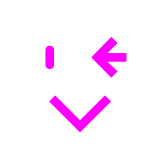Winking Face
😉 Meaning and usage
The primary meaning of the 😉 emoji is a wink . But depending on the context, it can convey a whole range of emotions and intentions:
😉 Flirting and playfulness: The most classic use case. The smiley softens the message, adds a touch of lightness, and hints at romantic or friendly interest.
- Example: "You look great today 😉"
😉 Joke or sarcasm: A wink indicates that what's said isn't meant to be taken seriously. It's the nonverbal equivalent of saying, "I'm just kidding!"
- Example: "You're a genius for forgetting your house keys... 😉"
😉 Secret or conspiracy: The smiley can mean “We have our own little secret” or “I know something that others don’t know.”
- Example: "Don't worry about tomorrow, I've already sorted everything out 😉"
😉 Friendly approval or "it's okay": Used to show support or that you are on the same page with the other person.
- Example: "Thanks for helping! You're the best 😉"
😉 A real-life wink replacement: We can't wink in text, so this emoji perfectly captures the gesture—friendly, a little conspiratorial, and warm.
How the smiley came to be 😉
The history of this symbol goes back to the distant pre-Internet past.
-
Emoticons (1982): It all started with simple text combinations known as "emoticons" (emoticon = emotion + icon). The wink was one of the earliest such symbols and looked like
;-)or;).-
A semicolon
;is a closed eye. -
The hyphen
-(sometimes it was omitted) is a conventional nose. -
The bracket
)is a smile.
This emoticon was proposed by Professor Scott Fahlman in 1982 on a university bulletin board to indicate humorous messages.
-
-
Emoji (1999): In the late 1990s, the first emoji—graphic images of emotions, objects, and symbols—appeared in Japan. The set of emoji created by Shigetaka Kurota for a Japanese mobile operator included the winking smiley.
-
Unification and globalization: With the proliferation of smartphones and social media, emojis have become a universal language. The smiley face
😉was standardized by the Unicode consortium and now looks virtually identical on all devices, although the design varies slightly (for example, on Apple, Google, and Samsung).
Interesting facts about 😉
-
Age is no barrier: It's one of the most popular emojis among users over 40, while younger users often consider it old-fashioned and use it for an ironic or "boomer" tone.
-
Cultural differences: In some cultures (such as China), winking may be considered a rude or impolite gesture, so the use of the emoticon
😉may be misunderstood. -
Earliest "wink": One of the first documented uses
;-)in digital communication dates back to September 10, 1982—just one day after Scott Fahlman suggested using it:-)to mean jokes. -
Not just a face: The wink emoji is used so often that variations have emerged, such as the "Winking Face with Tongue Sticking Out" 😜, which enhances the playful and humorous connotation.
😉 is a small but powerful digital communication tool that helps convey nuances that are lost in plain text. It saves from misunderstandings, adds warmth to messages, and has remained a faithful companion to our online conversations for decades.
Check Winking Face (😉) emoji codes for devs:
Codepoints
Bytes (UTF-8)
HTML hex
HTML dec
URL escape code
Punycode
JavaScript, JSON, Java
C, C++, Python
CSS
PHP, Ruby
Perl
Unicode Name
Apple Name
Also Known As
Wink Face
Winky Face
Shortcodes
:wink:
How emoji 😉 looks on Apple Iphone, Android and other platforms

























